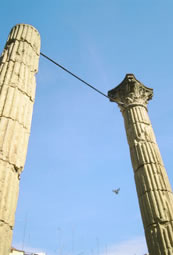
Roman Heritage
At the end of the 3rd century bC, the territory of Catalonia was involved in the Second Punic War. The roman general Cornelius Scipion disembarked in Empúries at the end of summer in 218 aC and, after beating the Punic people just in the first battle, he founded the first roman settlement in Hispania: Tarraco (Tarragona). Once the war finished, Catalonia was annexed to the Roman Republic politically and militarily. Then, the complex historical process of Romanization started and it brought the political, social, cultural and linguistic assimilation of the autochthonous population within the roman civilization universe.This process, however, was really slow. During the entire 2nd century bC and in spite of adapting the new situation, the indigenous communities developed with a certain autonomy, sustaining and developing their habits, life style and own culture. It was a very dynamic period of transition, when continuity and change are linked. The establishment of the imperium and the definite pacification of the Iberian peninsula, which was achieved by August at the end of the Cantabrian wars, favored the beginning of a long phase of prosperity, which soon reflected the trend of the cities related on embellish their monuments and public buildings.
Precisely in Tarraco we have one of the most spectacular examples of the new monumental trends. From the August’s times, the Hispania Tarraconensis capital assumed its role of one of the most important cities of the whole roman west, so in just one century, the 1st bC, the city transformed itself considerably with the application of successive constructive programs of great importance, which were undoubtedly promoted from Rome with the clear wish of converting the city into a symbol of the imperial authority. The defensive walls, the circus, the theater, amphitheatre, the Provincial Forum and the Forum of the City are some of the most distinguished vestiges of Tarraco.
In the 4th century bC, the Christianity became the hegemonic religion in all the imperium so we can encompass an important part of its artistic production just on the set of the Paleo-Christian art. It was a religious style which took the same roman forms and art typology to find a new functionality together with its own ideological contents. It constituted a very clear symbolic universe. A monument of first order is the mausoleum of Centelles of Constantí, near Tarragona, constructed in the middle of IV century.
Thanks to the influence of the capital, the Costa Daurada has inherited an important roman heritage which has been spread out on the rest of the territory. Many cities have documented different roman signs in the shape of architecture, sculpture, mosaics and painting; aspects that fulfill, undoubtedly, the utilitarian and practical characteristics of the roman thought.
